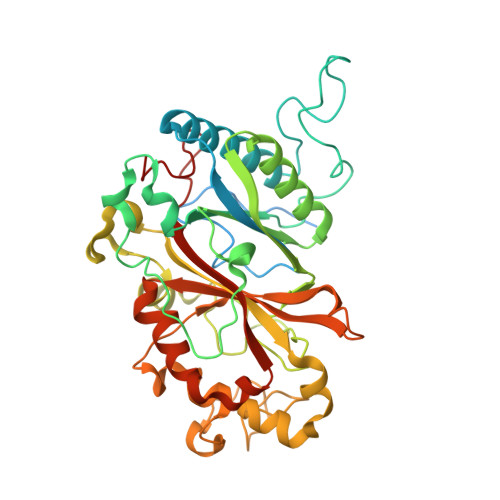New insights into controlling radical migration pathways in heme enzymes gained from the study of a dye-decolorising peroxidase.
Lucic, M., Wilson, M.T., Pullin, J., Hough, M.A., Svistunenko, D.A., Worrall, J.A.R.(2023) Chem Sci 14: 12518-12534
- PubMed: 38020392
- DOI: https://doi.org/10.1039/d3sc04453j
- Primary Citation of Related Structures:
8OLH, 8OLP, 8OMC - PubMed Abstract:
In heme enzymes, such as members of the dye-decolorising peroxidase (DyP) family, the formation of the highly oxidising catalytic Fe(iv)-oxo intermediates following reaction with hydrogen peroxide can lead to free radical migration (hole hopping) from the heme to form cationic tyrosine and/or tryptophan radicals. These species are highly oxidising (∼1 V vs. NHE) and under certain circumstances can catalyse the oxidation of organic substrates. Factors that govern which specific tyrosine or tryptophan the free radical migrates to in heme enzymes are not well understood, although in the case of tyrosyl radical formation the nearby proximity of a proton acceptor is a recognised facilitating factor. By using an A-type member of the DyP family (DtpAa) as an exemplar, we combine protein engineering, X-ray crystallography, hole-hopping calculations, EPR spectroscopy and kinetic modelling to provide compelling new insights into the control of radical migration pathways following reaction of the heme with hydrogen peroxide. We demonstrate that the presence of a tryptophan/tyrosine dyad motif displaying a T-shaped orientation of aromatic rings on the proximal side of the heme dominates the radical migration landscape in wild-type DtpAa and continues to do so following the rational engineering into DtpAa of a previously identified radical migration pathway in an A-type homolog on the distal side of the heme. Only on disrupting the proximal dyad, through removal of an oxygen atom, does the radical migration pathway then switch to the engineered distal pathway to form the desired tyrosyl radical. Implications for protein design and biocatalysis are discussed.
- School of Life Sciences, University of Essex Wivenhoe Park Colchester Essex CO4 3SQ UK jworrall@essex.ac.uk svist@essex.ac.uk.
Organizational Affiliation:

















